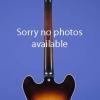"The House of the Rising Sun"
This wonderful lightweight bass weighs just 8.00 lbs. and has a nice, fat nut width of 1 11/16 inches and a short scale length of 30 1/2 inches. Laminated maple top, back, and sides, one-piece mahogany neck, and rosewood fretboard with 20 frets and inlaid pearl dot position markers. Headstock with inlaid pearl "Epiphone" logo and vertical oval pearl inlay. Original banjo-style tuners with rear facing white plastic bell-shaped buttons. Single black plastic-covered PAF pickup with four polepieces and a huge output of 14.70k. Tortoiseshell pickguard with silver Epiphone "E" logo. Two controls (one volume, one tone), a two-way metal bass/baritone switch, and jack socket, all on body. Gold plastic bell-shaped knobs. The potentiometers are stamped "134 929" (Centralab July 1959). Combination bar bridge/stud tailpiece. Inside the bass f-hole is an Epiphone (Kalamazoo, Michigan) rectangular blue label with "Rivoli" and "EBV-232" typed in black and the serial number ("A-3314") stamped in red. Inside the treble f-hole the batch number "S3546 67" is stamped in black. Some minor surface chipping to the lower edge of the top, minimal belt buckle scarring on the back, a few small marks on the back of the neck, some minor wear to the edges of the headstock, and some checking to the body finish. Overall, a wonderful example, in excellent plus (8.75) condition, of this extremely rare and very early bass guitar, with the original two-way switch which was soon after changed to the usually found bass/baritone pushbutton switch. Housed in its original Epiphone brown hardshell case with purple plush lining (8.50).
"The New York-based Epiphone company was bought by Gibson in 1957. One of the first so-called 'Gibson Epiphone' products was the Rivoli Bass of 1959, virtually identical to Gibson's EB-2...The Rivoli proved especially popular with 1960s British bassists such as The Animals' Chas Chandler" (Tony Bacon and Barry Moorhouse, The Bass Book, p. 19).
Translate:


